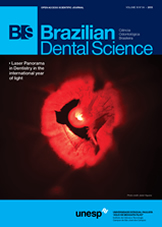Variations in soft facial tissue by using the interocclusal stabilization splint: 3d stereophotogrammetry
DOI:
https://doi.org/10.14295/bds.2015.v18i4.1163Resumo
Objective: To analyze variations in soft facial tissue by using the interocclusal stabilization splint (ISS) through the 3D stereophotogrammetry technique in a group of young women with temporomandibular disorder (TMD). Material and Methods: 20 females between 20 and 60 years of age (39.3 ± 12.5) and TMD diagnosis based on the criteria of the RDC/TMD, received treatment with ISS. Reference points were marked on the face and photos were performed twice using the Vectra (M3–Canfield®): with and without ISS. In the 3D images the following variables were measured: area of the cheeks and lips (cm3), linear labial distances (Ls-Cph, Cph-Ch, Li-Ch, Ls-Li, Ch-Ch), lower third of the face (Sn-Me), height of the upper lip (Sn-Ls)/lower (Li-Me) and the angles C-Sn-Ls, N-Sn-Pg and Li-Sl-Pg. The data were analyzed in a descriptive manner, the times with and without ISS were compared using the t-test and the Pearson's correlation was employed in order to correlate the ISS thickness with the facial measurements (5% significance). Results: A statistically significant difference was found only for the variables of the lip area (p= 0.01) and Ls-Li (p=0.006) in comparison with/without ISS. No correlation was found between the ISS thickness and the lip area for both face sides, right (p=0.7; r=0.07) and left (p=0.9; r=-0.001). Conclusions: The use of interocclusal stabilization splint does not provide large changes in facial morphology, with the exception of the lip area and height.Downloads
Downloads
Arquivos adicionais
Publicado
Como Citar
Edição
Seção
Licença
TRANSFERÊNCIA DE DIREITOS AUTORAIS E DECLARAÇÃO DE RESPONSABILIDADE
Toda a propriedade de direitos autorais do artigo "____________________________________________________________________" é transferido do autor(es) para a CIÊNCIA ODONTOLÓGICA BRASILEIRA, no caso do trabalho ser publicado. O artigo não foi publicado em outro lugar e não foi submetido simultaneamente para publicação em outra revista.
Vimos por meio deste, atestar que trabalho é original e não apresenta dados manipulados, fraude ou plágio. Fizemos contribuição científica significativa para o estudo e estamos cientes dos dados apresentados e de acordo com a versão final do artigo. Assumimos total responsabilidade pelos aspectos éticos do estudo.
Este texto deve ser impresso e assinado por todos os autores. A versão digitalizada deverá ser apresentada como arquivo suplementar durante o processo de submissão.




























